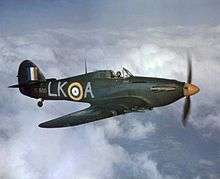No. 516 Squadron RAF
No. 516 Squadron RAF was an army co-operation squadron of the Royal Air Force during the Second World War.
| No. 516 Squadron RAF | |
|---|---|
| Active | 28 April 1943 – 2 December 1944 |
| Country | |
| Branch | |
| Role | army co-operation |
| Part of | No. 105 (Combined Operations) Wing RAF |
| Base | RAF Dundonald |
| Insignia | |
| Squadron Codes | No codes are known to have been carried between Apr 1943 and Dec 1944[1][2] |
History
No. 516 Squadron was formed on 28 April 1943 at RAF Dundonald from 1441 (Combined Operations) Flight on 28 April 1943.[3] Its role was to provide realistic training facilities to the Combined Operations Training Centre and other training units in the Western Scotland area. It operated a large variety of aircraft with the unusual task to provide realistic low-level attacks against commando and assault troops undergoing training. The work involved detaching aircraft near the troop training areas including RAF Ayr and RAF Haverfordwest. By 1944 the training of commando and assault troops was on the decline and the squadron was disbanded at Dundonald on 2 December 1944.
Aircraft operated

| From | To | Aircraft | Version |
|---|---|---|---|
| April 1943 | December 1943 | Westland Lysander | Mks.II, IIIa |
| April 1943 | February 1944 | North American Mustang | Mk.I |
| April 1943 | December 1944 | Avro Anson | Mk.I |
| May 1943 | December 1944 | Bristol Blenheim | Mk.IV |
| December 1943 | December 1944 | Hawker Hurricane | Mks.IIb, IIc |
References
Citations
- Bowyer and Rawlings 1979, p. 148.
- Flintham and Thomas 2003, p. 232.
- Sturtivant and Hamlin 2007, p. 123.
- Rawlings 1982, p. 257.
- Halley 1988, p. 396.
- Jefford 2001, p. 97.
Bibliography
- Bowyer, Michael J.F. and John D.R. Rawlings. Squadron Codes, 1937–56. Cambridge, UK: Patrick Stephens Ltd., 1979. ISBN 0-85059-364-6.
- Flintham, Vic and Andrew Thomas. Combat Codes: A full explanation and listing of British, Commonwealth and Allied air force unit codes since 1938. Shrewsbury, Shropshire, UK: Airlife Publishing Ltd., 2003. ISBN 1-84037-281-8.
- Halley, James J. The Squadrons of the Royal Air Force & Commonwealth, 1981–1988. Tonbridge, Kent, UK: Air-Britain (Historians) Ltd., 1988. ISBN 0-85130-164-9.
- Jefford, C.G. RAF Squadrons, a Comprehensive Record of the Movement and Equipment of all RAF Squadrons and their Antecedents since 1912. Shrewsbury, Shropshire, UK: Airlife Publishing, 2001. ISBN 1-84037-141-2.
- Jones, Phil. Airfield Focus No. 35: Dundonald. Peterborough, UK: GMS Enterprises, 1998. ISBN 1-870384-66-0.
- Rawlings, John D.R. Coastal, Support and Special Squadrons of the RAF and their Aircraft. London: Jane's Publishing Company Ltd., 1982. ISBN 0-7106-0187-5.
- Shears, Doug. Damn my Two Left Feet....and how I Flew with Them. Timaru, New Zealand: Jeff Mill & Associates, 2001. ISBN 0-9582280-0-0. Doug was a pilot with 516 and the book includes a chapter on his experiences with them.
- Sturtivant, Ray, ISO and John Hamlin. RAF Flying Training And Support Units since 1912. Tonbridge, Kent, UK: Air-Britain (Historians) Ltd., 2007. ISBN 0-85130-365-X.
